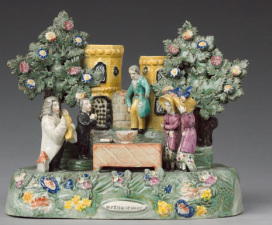Traditionally and correctly, the three Rs of restoration are:
- Repaired: This word describes a reattachment of original material. If an arm breaks off and is reattached, this is a repair. It simply puts the original material back together. Aside from a perfect figure, this is usually the best state of affairs because all the original material is put back in place. As one of my dealer friends puts it, "It is all there!"
- Restored: This word describes the addition of new material. If an arm is lost and a new one is made, that is restoration. You would then describe the arm as restored.
- Replaced. Theoretically, repair and restoration cover all scenarios, but sometimes those words are just not clear enough. Imagine you have a large composite group with several figures on it--for example a tithe pig group. If the parson on the group has a restored arm, a condition report should state "parson restored." But what if the whole figure of the parson has been lost and a new one made up? "Parson restored" again says it----but does that go far enough? I think not, and in those circumstance, "parson replaced" says it better. It makes it crystal clear that the whole figure is restored, rather than just a part of it.
As we have these three perfectly adequate R words at our disposal, what more could we want? I am at a loss to understand why, but I find these words creeping into descriptions:
- Remodeled. If a figure has a 'remodeled' head or arm, it is restored. Let's call a spade a spade!
- Renewed. If a head or arm or any other part of a figure is 'renewed', it is restored. Why call it anything else?
- Reglued. This one beats me. As none of the components of our figures was ever glued in the first place, how can anything be REglued? I guess that this term is intended to describe a repair, i.e. the simply reattachment of a broken piece. "Repair" is the word to use.
As the words repair, restoration, and replacement cover all scenarios, what more do we need? Well, elaboration is often helpful. "Bocage restored" sounds awfully dire. It suggests that much of the bocage is new material, yet the restoration might just be to a leaf tip or two. So saying something like "three bocage leaf tips restored" tells us exactly what we need to know.
Let's look at this "Sherratt" christening group that recently sold at auction.

As you see from the example alongside, a mother with child does not appear in a christening group. The small figure missing from the auctioned example is a vicar holding a child.
Somebody parted with a hunk of money at auction for the christening group that we now know is missing a vicar, and I hope that person knew at the time what he/she bought. Once that group is "fixed", the correct way to describe the added figure would be "figure of vicar replaced." Assuming the new owner attaches instead the mother and child, the description should read "figure of mother replaced". This clearly tells you that the figure is NOT original to the group.














